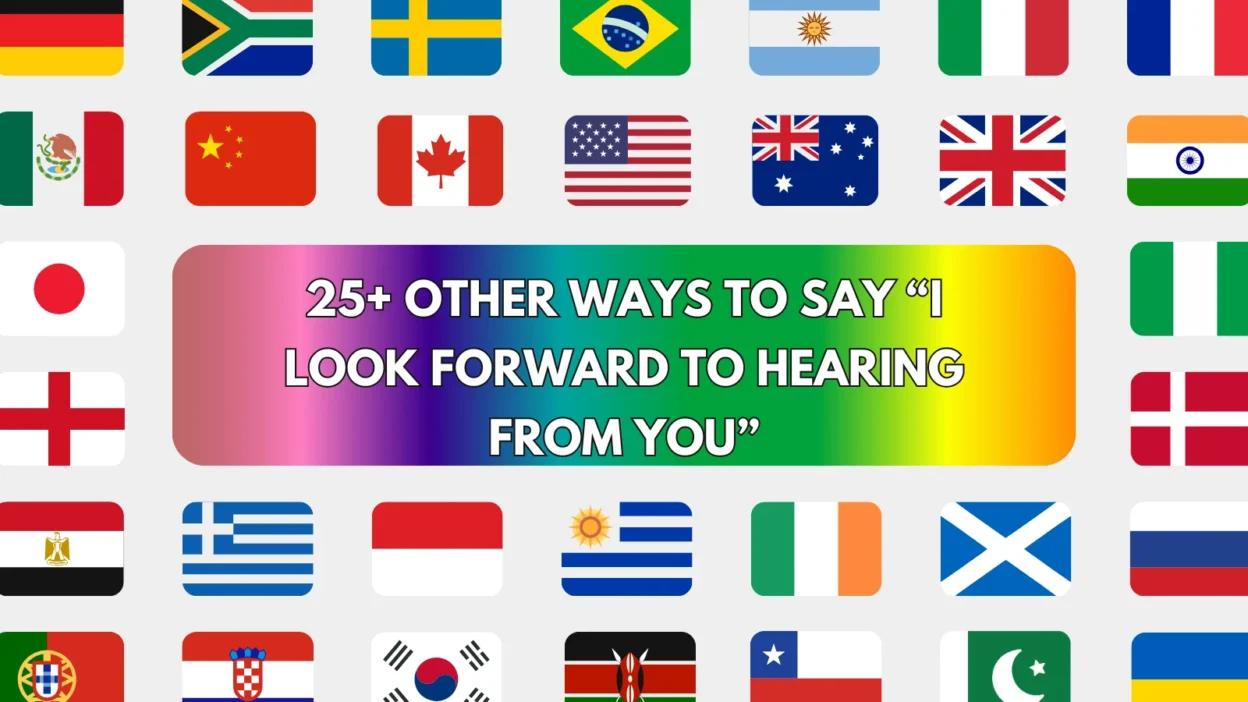The phrase “I look forward to hearing from you” is one of the most commonly used closings in emails and letters. It expresses eagerness to receive a reply, confirmation, or next steps. While it’s professional and polite, using it repeatedly can feel repetitive or impersonal.
To help you write with variety and clarity, this article provides 25 alternative ways to say “I look forward to hearing from you” — with detailed meanings, use cases, and example sentences to match your message’s tone and purpose.
1. I await your response
Meaning:
Expresses that you’re waiting for a reply.
Detailed Explanation:
Slightly more formal and direct than the original phrase, showing anticipation for communication.
Scenario Example:
Please let me know your availability. I await your response.
Best Use:
Formal emails, business communication.
Tone:
Professional, respectful.
2. I’m eager to hear your thoughts
Meaning:
Shows interest in the recipient’s opinion or response.
Detailed Explanation:
This version adds warmth and openness, encouraging dialogue.
Scenario Example:
Here’s the draft of our plan — I’m eager to hear your thoughts.
Best Use:
Team discussions, collaborations.
Tone:
Friendly, constructive.
3. I hope to hear from you soon
Meaning:
A polite way of expressing the desire for a timely response.
Detailed Explanation:
Gentler in tone, ideal for both personal and professional emails.
Scenario Example:
Thanks for considering my request. I hope to hear from you soon.
Best Use:
General email closings, job applications.
Tone:
Polite, hopeful.
4. Please keep me posted
Meaning:
Asks the recipient to provide updates or information.
Detailed Explanation:
Casual yet attentive, this is useful when follow-ups are needed.
Scenario Example:
Once you have an update, please keep me posted.
Best Use:
Ongoing projects, informal communication.
Tone:
Friendly, cooperative.
5. Looking forward to your reply
Meaning:
A simpler and shorter alternative that maintains politeness.
Detailed Explanation:
Perfect for quick emails where a response is expected.
Scenario Example:
Let me know what works best. Looking forward to your reply.
Best Use:
Everyday work emails, scheduling.
Tone:
Neutral, polite.
6. Awaiting your feedback
Meaning:
Directly asks for comments or evaluation.
Detailed Explanation:
Best when expecting thoughts on a specific document or proposal.
Scenario Example:
I’ve attached the presentation. Awaiting your feedback.
Best Use:
Project updates, client work.
Tone:
Professional, concise.
7. I’ll appreciate your response
Meaning:
Shows that the reply is not just expected but valued.
Detailed Explanation:
Adds appreciation, creating a more polite tone.
Scenario Example:
Please review the document. I’ll appreciate your response.
Best Use:
Customer service, polite follow-ups.
Tone:
Grateful, courteous.
8. I hope we can connect soon
Meaning:
Indicates a desire to speak or meet again.
Detailed Explanation:
Useful when scheduling calls, meetings, or discussions.
Scenario Example:
Let me know a good time — I hope we can connect soon.
Best Use:
Networking, relationship-building.
Tone:
Warm, optimistic.
9. Let me know what you think
Meaning:
Invites the recipient to share their opinion or feedback.
Detailed Explanation:
More casual and conversational than the original phrase.
Scenario Example:
Here’s the latest version. Let me know what you think.
Best Use:
Collaborative work, informal emails.
Tone:
Friendly, open.
10. Waiting to hear back from you
Meaning:
Clearly states that a response is expected.
Detailed Explanation:
More casual than “awaiting your response,” still effective.
Scenario Example:
Sent over the contract — waiting to hear back from you.
Best Use:
Teamwork, casual business communication.
Tone:
Informal, direct.
11. Feel free to get in touch
Meaning:
Gives the other person permission and encouragement to reply.
Detailed Explanation:
Less about urgency, more about openness to future communication.
Scenario Example:
If you have any thoughts or questions, feel free to get in touch.
Best Use:
Supportive messaging, open invitations.
Tone:
Casual, approachable.
12. Let’s touch base soon
Meaning:
Suggests reconnecting or checking in.
Detailed Explanation:
Often used in workplace settings to keep conversations going.
Scenario Example:
Thanks for your input today — let’s touch base soon.
Best Use:
Team updates, ongoing communication.
Tone:
Professional, casual.
13. I’d appreciate hearing from you
Meaning:
Adds gratitude and politeness to a request for reply.
Detailed Explanation:
Softens the request and creates a respectful tone.
Scenario Example:
Let me know your decision. I’d appreciate hearing from you.
Best Use:
Polite inquiries, proposals.
Tone:
Gracious, respectful.
14. I look forward to your thoughts
Meaning:
Shows you value the person’s opinion.
Detailed Explanation:
Ideal when seeking feedback, suggestions, or creative ideas.
Scenario Example:
Here’s the concept — I look forward to your thoughts.
Best Use:
Brainstorms, creative collaboration.
Tone:
Encouraging, collaborative.
15. Let me know at your earliest convenience
Meaning:
Requests a reply as soon as the recipient is able.
Detailed Explanation:
Very polite and flexible, shows understanding of their time.
Scenario Example:
Please confirm the date. Let me know at your earliest convenience.
Best Use:
Polite business communication.
Tone:
Courteous, professional.
16. Please don’t hesitate to reply
Meaning:
Encourages the person to respond comfortably.
Detailed Explanation:
Great for removing hesitation, especially in formal settings.
Scenario Example:
If you have questions, please don’t hesitate to reply.
Best Use:
Customer support, client interactions.
Tone:
Friendly, welcoming.
17. I welcome your input
Meaning:
Shows genuine interest in what the other person thinks.
Detailed Explanation:
Creates a collaborative environment where feedback is appreciated.
Scenario Example:
I’ve included the details below. I welcome your input.
Best Use:
Team communication, shared projects.
Tone:
Inclusive, positive.
18. Hoping to hear from you
Meaning:
A soft and hopeful way to express expectation.
Detailed Explanation:
Less formal, but still clearly shows you’re waiting for a reply.
Scenario Example:
I’d love to discuss further. Hoping to hear from you.
Best Use:
Personal communication, gentle follow-ups.
Tone:
Hopeful, kind.
19. Let me know your thoughts
Meaning:
Direct request for feedback or opinion.
Detailed Explanation:
Informal and straight to the point — ideal for fast-moving conversations.
Scenario Example:
Let me know your thoughts on the proposal.
Best Use:
Team chats, creative review.
Tone:
Direct, neutral.
20. I look forward to your feedback
Meaning:
Politely invites comments, suggestions, or evaluations.
Detailed Explanation:
Similar to the original but more specific about what kind of response is expected.
Scenario Example:
Here’s the latest draft. I look forward to your feedback.
Best Use:
Reviews, performance or project updates.
Tone:
Professional, constructive.
21. Reach out if you need anything
Meaning:
Opens the door for future communication or help.
Detailed Explanation:
Puts the control in their hands, showing you’re available.
Scenario Example:
Hope this covers everything. Reach out if you need anything.
Best Use:
Customer service, informal messages.
Tone:
Helpful, open.
22. I’m here if you have questions
Meaning:
Encourages a reply without demanding it.
Detailed Explanation:
Shows availability without pressuring the other person.
Scenario Example:
I’ve attached the info. I’m here if you have questions.
Best Use:
Supportive roles, FAQ responses.
Tone:
Friendly, reassuring.
23. I hope we’ll be in touch
Meaning:
Suggests future communication, without immediate pressure.
Detailed Explanation:
Best for closing a conversation politely when no immediate reply is needed.
Scenario Example:
Thanks for the interview — I hope we’ll be in touch.
Best Use:
Endings, applications, networking.
Tone:
Hopeful, polite.
24. Keep me in the loop
Meaning:
Requests updates or notifications as things progress.
Detailed Explanation:
Casual phrase used often in teamwork or project settings.
Scenario Example:
If anything changes, keep me in the loop.
Best Use:
Internal teams, casual updates.
Tone:
Friendly, relaxed.
25. I appreciate your time and look forward to hearing from you
Meaning:
Combines gratitude with an expectation of response.
Detailed Explanation:
Balances professionalism and politeness — a polished way to end any message.
Scenario Example:
Thanks again for reviewing the document. I appreciate your time and look forward to hearing from you.
Best Use:
Professional closings, formal emails.
Tone:
Respectful, appreciative.
Conclusion
A thoughtful sign-off can shape how your message is received. Whether you’re writing a formal proposal, friendly email, or customer support response, these 25 alternative ways to say “I look forward to hearing from you” give you the variety and tone you need to stay polite, engaging, and effective.




